Are you looking for shoulder press standards? Then keep reading! Because today, I’ll be sharing my 10 favorite shoulder press statistics for 2021.
My research and number crunching have revealed:
- Shoulder press world records.
- Average shoulder press weight for the average American.
- Shoulder press benchmarks for different body weights and training levels.
- Male and female shoulder press standards.
- How many people can shoulder press 1x and 2x their bodyweight.
- Why shoulder pressing is the best exercise to develop your shoulders.
- Why the dumbbell shoulder press is superior to the kettlebell shoulder press (for shoulder development).
Here we go!
- 1. World Records For The Shoulder Press.
- 2. Shoulder Press Standards For The Average American.
- 3. Shoulder Press Standards For Men Based On Bodyweight.
- 4. Shoulder Press Standards For Women Based On Bodyweight.
- 5. Percentage Of People Able To Shoulder Press 1x Their Bodyweight.
- 6. Percentage Of People Able To Shoulder Press 2x Their Bodyweight.
- 7. Weight-Range Of The Shoulder Press Based On Gender.
- 8. Shoulder Press Strength Progression Based On Gender.
- 9. Shoulder Pressing Is The Best Exercise To Develop Your Shoulders.
- 10. Shoulder Pressing With Kettlebells Vs Dumbbells.
- Recap: Recommended Shoulder Press Setup At Home
- Conclusion
1. World Records For The Shoulder Press.
The world record for the heaviest male shoulder press belongs to Cheick Sanou (from Bobo-Dioulasso), who shoulder pressed 573 pounds in 2020. The world record for the heaviest female shoulder press belongs to Andrea Thompson (from the UK), who shoulder pressed 297.7 pounds in 2019.
| Shoulder Press World Record Title: | Title Holder: |
|---|---|
| Heaviest Male | Cheick Sanou 2020 (573 pounds) |
| Heaviest Female | Andrea Thompson 2019 (297.7 pounds) |
Since shoulder pressing is not officially recognized in the Olympic powerlifting divisions, I had to be creative in my research.
These world records are to the best of my knowledge. And if you have other suggestions, then please let me know in the comments below!
Checik Sanou, also known by his nickname “Iron Biby”, completed his gargantuan 573 pound shoulder press in 2020.
The location was not stated in the video description.
But the background suggests it was filmed at the Burkina Faso training camp, where he has broken previous world records.
Andrea Thompson, completed her 297.7 pound shoulder press at the 2019 World Ultimate Strongman contest.
The press was actually a log press and not a barbell press.
But since the movements are very similar, I decided to qualify it as a world record shoulder press!
Read my other article to learn about the benefits of barbell training!
2. Shoulder Press Standards For The Average American.
The average American man weighing 200 pounds, should be able to shoulder press approximately 120 pounds at a novice to intermediate training level. The average American woman weighing 170 pounds, should be able to shoulder press approximately 59 pounds at a novice to intermediate training level.
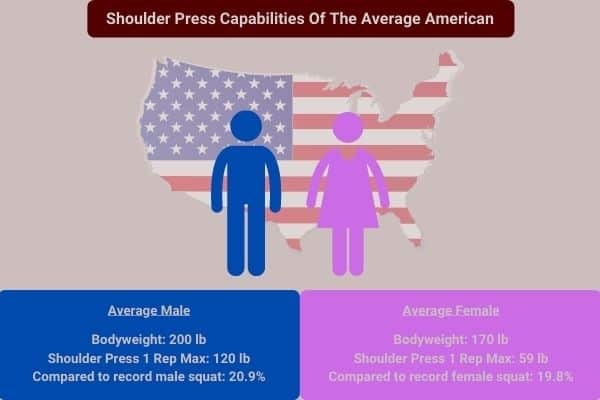
How I produced this statistic:
First of all, Healthline notes that the average American weighs:
- Male- 200 pounds.
- Female– 170 pounds.
I then combined this information with Strength Level’s shoulder press 1RM database (1RM being “1 rep max”, which is the maximum weight someone can lift for 1 repetition).
According to the database, this is how much the average 200-pound male can shoulder press:
| Beginner 1 RM (lb) | Novice 1 RM (lb) | Intermediate 1 RM (lb) | Average 1 RM (lb) |
|---|---|---|---|
| 85 | 118 | 157 | 120 |
I averaged the male shoulder press 1RMs for beginners/novices/intermediates to conclude that the average American male should be able to shoulder press 120 pounds.
That’s 20.9% of Iron Biby’s 573-pound male world record!
Next, this is how much a 170-pound female can shoulder press:
| Beginner 1 RM (lb) | Novice 1 RM (lb) | Intermediate 1 RM (lb) | Average 1 RM (lb) |
|---|---|---|---|
| 36 | 57 | 83 | 59 |
Again, I averaged the female shoulder press 1RMs for beginners/novices/intermediates to conclude that the average American female should be able to shoulder press 59 pounds.
That’s 19.8% of Andrea Thompson’s 297.7 pound female world record!
Note: 1RM refers to 1-rep max. If you don’t know what this is you can go to my other article for a full explanation of RM’s in weight training.
3. Shoulder Press Standards For Men Based On Bodyweight.
An untrained man should be able to shoulder press 0.5x his bodyweight. With 2 years of training, shoulder press strength should increase to 0.8x bodyweight. And with 5 years of training, a man should be able to shoulder press between 1.0x to 1.2x his bodyweight.

How I produced this statistic:
I turned to Strength Level’s database of 636,00 user-shoulder presses (559,000 male shoulder presses and 77,000 female shoulder presses) to reveal the average shoulder press 1RMs for males and females.
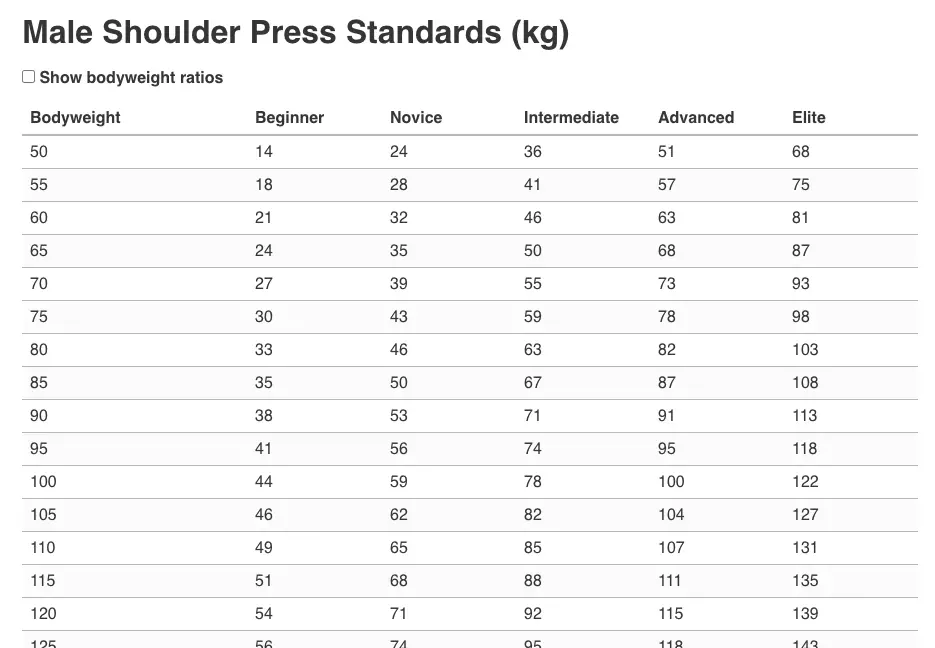
The data revealed the average shoulder press 1RMs according to each user’s bodyweight and training level.
Training level is defined as the following:

This allowed me to plot the shoulder press 1RMs as a line graph, showing the relationship between shoulder press 1RM, bodyweight, and training level in men and women.
You can see the line graphs in fig 1. and fig 2. below.
Here’s fig 1., showing men’s shoulder press standards (based on bodyweight and training level):
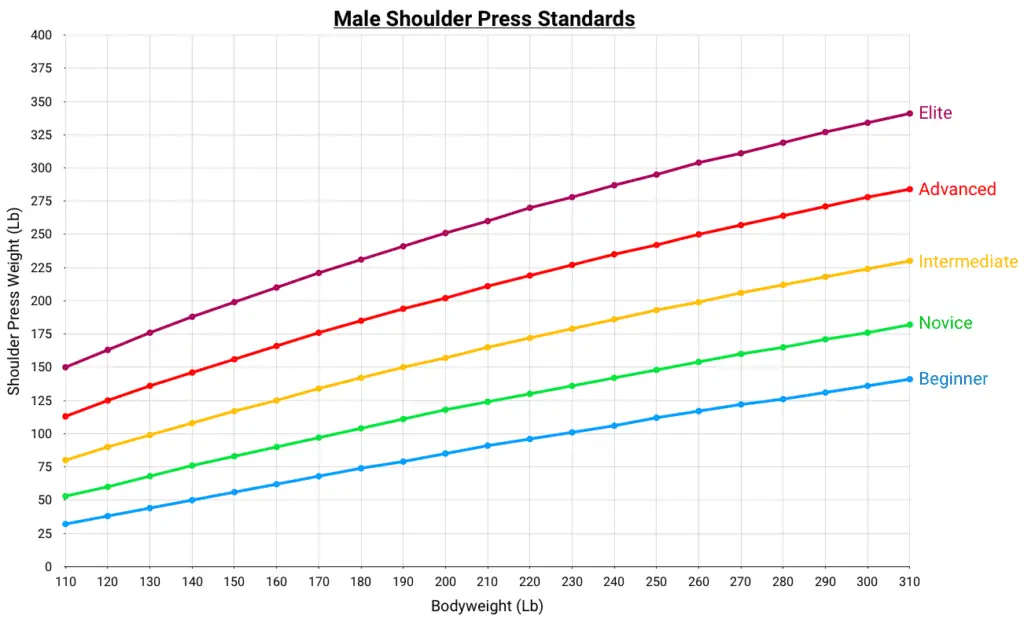
Next, I converted each shoulder press 1RM into a multiple of the bodyweight at which it was made.
As an example- a 50 pound shoulder press made at 140 pound bodyweight would equal 0.34x bodyweight.
Then I repeated these calculations for all 1RMs, at all body weights and training levels.
Finally, I took the average for each training level.
Here are the average male shoulder press 1RMs as a multiple of bodyweight, based on training level:
- Beginners- should be able to shoulder press an average of 0.4x his bodyweight for 1 repetition.
- Novices- should be able to shoulder press an average of 0.6x his bodyweight for 1 repetition.
- Intermediates- should be able to shoulder press an average of 0.8x his bodyweight for 1 repetition.
- Advanced- should be able to shoulder press an average of 1.0x his bodyweight for 1 repetition.
- Elites- should be able to shoulder press an average of 1.2x his body weight for 1 repetition.
Check out my other post to find out your ideal weightlifting load!
4. Shoulder Press Standards For Women Based On Bodyweight.
An untrained woman should be able to shoulder press 0.25x her bodyweight. With 2 years training, shoulder press strength should increase to 0.5x bodyweight. And with 5 years training, a woman should be able to shoulder press between 0.7x to 0.9x her bodyweight.
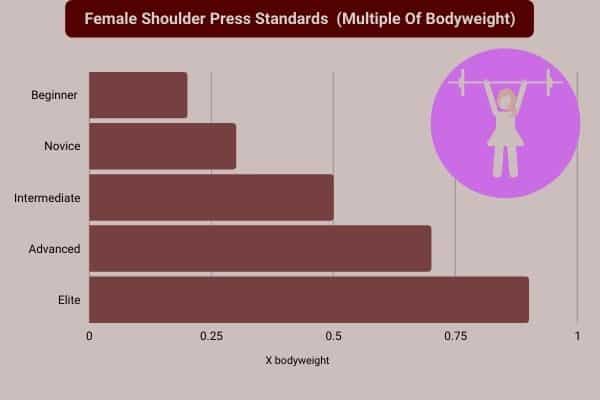
How I produced this statistic:
These shoulder press standards were produced with the same method used to produce the male standards (see above bullet point 3.)
Here’s fig 2., showing women’s shoulder press standards (based on bodyweight and training level):
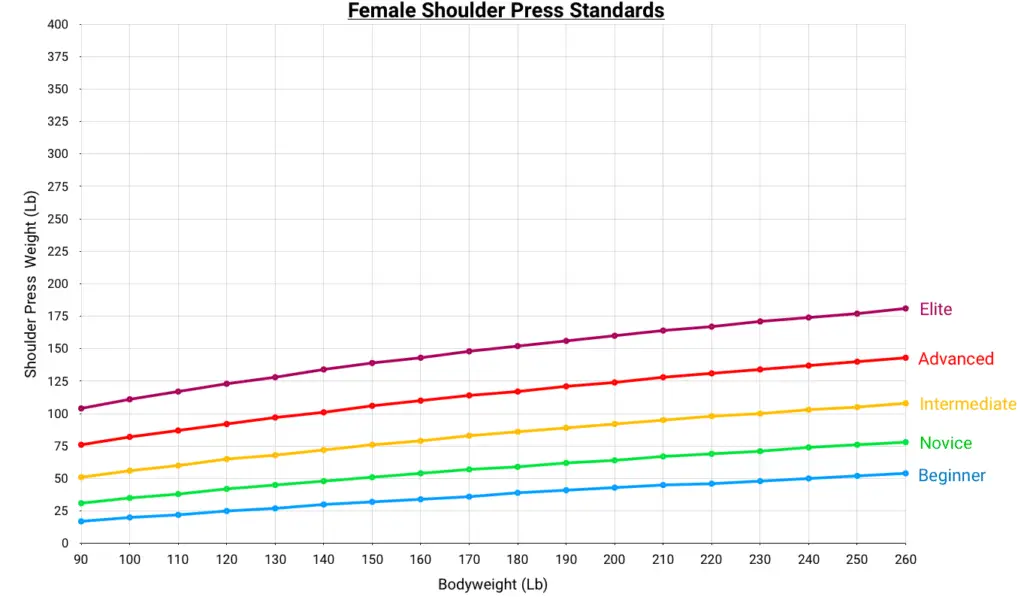
Again, I converted each shoulder press 1RM into a multiple of the bodyweight at which it was made.
This was repeated for all 1RMs at all body weights and training levels.
Here are the average female shoulder press 1RMs as a multiple of bodyweight, based on training level:
- Beginners- should be able to shoulder press an average of 0.2x her bodyweight for 1 repetition.
- Novices- should be able to shoulder press an average of 0.3x her bodyweight for 1 repetition.
- Intermediates- should be able to shoulder press an average of 0.5x her bodyweight for 1 repetition.
- Advanced- should be able to shoulder press an average of 0.7x her bodyweight for 1 repetition.
- Elites- should be able to shoulder press an average of 0.9x her bodyweight for 1 repetition.
5. Percentage Of People Able To Shoulder Press 1x Their Bodyweight.
19.7% of men aged 24 to 39 can shoulder press 1x their own bodyweight. In contrast, only 3.1% of women aged 24 to 39 can shoulder press 1x their own bodyweight. The difference of 16.6% is due to men having more muscle mass and strength, compared to women.
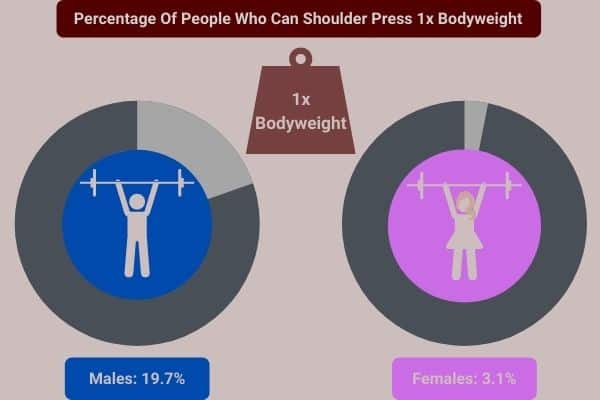
How I produced this statistic:
I turned to the Strength Level relative strength calculator, which provides data on the percentage of of people who can shoulder press 1x their bodyweight, at each specific bodyweight.
This allowed me to sample a range of male and and female body weights to determine the percentage of people who can shoulder press 1x their bodyweight.
Here’s a screenshot of the Strength Level calculator:
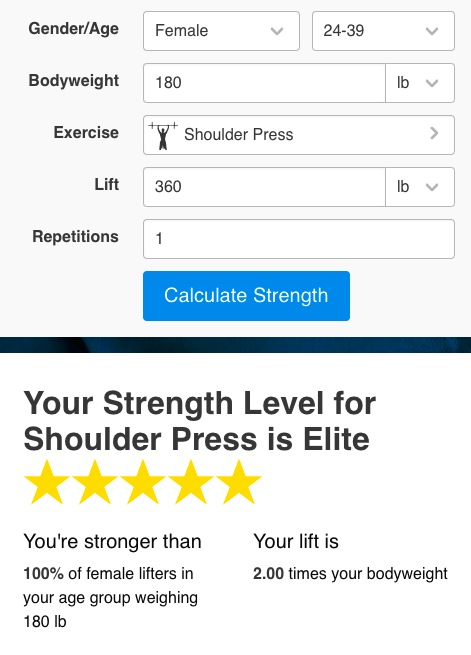
Here are the percentages of males (aged 24-39 at body weights of 110 pounds to 290 pounds) who can shoulder press 1x their bodyweight:
| Male Bodyweight (lb): | % Who Can Shoulder Press 1x Bodyweight |
|---|---|
| 110 | 22% |
| 140 | 24% |
| 170 | 23% |
| 200 | 21% |
| 230 | 19% |
| 260 | 16% |
| 290 | 13% |
| Average: | 19.7% |
The sampling showed that approximately 19.6% of males can shoulder press 1x their bodyweight.
Note: I only sampled body weights at 110 pounds to 290 pounds, as this represents the average male bodyweight across a population.
Next are the percentages of females (aged 24-39 at body weights of 90 pounds to 270 pounds) who can shoulder press 1x their bodyweight:
| Female Bodyweight (lb): | % Who Can Shoulder Press 1x Bodyweight |
|---|---|
| 90 | 11% |
| 120 | 6% |
| 150 | 3% |
| 180 | 1% |
| 210 | 0.5% |
| 240 | 0.2% |
| 270 | 0.07% |
| Average: | 3.1% |
The sampling showed that approximately 3.1% of females can shoulder press 1x their bodyweight.
Note: I only sampled body weights at 90 pounds to 270 pounds, as this represents the average female bodyweight across a population.
Therefore 16.6% more males can shoulder press 1x their bodyweight, compared to females.
What accounts for this difference?
This 2000 study attributes the difference i to men having more muscle mass than women.
Find out how to quickly build muscle in my other article!
6. Percentage Of People Able To Shoulder Press 2x Their Bodyweight.
0.05% of men aged 24 to 39 can shoulder press 2x their own bodyweight. In contrast, only 0.01% of women aged 24 to 39 can shoulder press 2x their own bodyweight. The difference of 0.04% is due to men having more muscle mass and strength, compared to women.
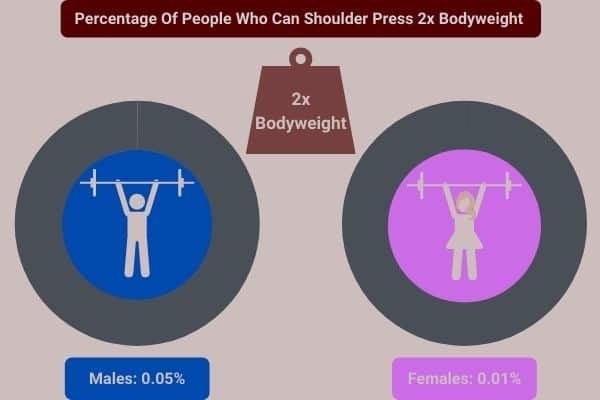
How I produced this statistic:
I used the same method as above (bullet point 5.) to sample the percentages of people who can shoulder press 2x their bodyweight
Here are the percentages of males (aged 24-39 at body weights of 110 pounds to 290 pounds), who can shoulder press 2x their bodyweight:
| Male Bodyweight (lb): | % Who Can Shoulder Press 2x Bodyweight |
|---|---|
| 110 | 0.2% |
| 140 | 0.08% |
| 170 | 0.03% |
| 200 | 0.01% |
| 230 | 0.003% |
| 260 | 0.0008% |
| 290 | 0.0002% |
| Average: | 0.05% |
Only a tiny 0.05% of men are able to shoulder press 2x their own bodyweight.
This seems extremely low, compared to other compound lifts such as the squat and bench press (exercises which often see people double their bodyweight).
But the shoulder press is an exercise which uses some of the smaller muscles in the body (triceps and deltoids). And this may explain why so few people can 2x their bodyweight on a shoulder press.
Next, here are the percentages of females (aged 24-39 at body weights of 90 pounds to 270 pounds), who can shoulder press 2x their bodyweight:
| Female Bodyweight (lb): | % Who Can Shoulder 2x Bodyweight |
|---|---|
| 90 | 0.04% |
| 120 | 0.003% |
| 150 | 0.0002% |
| 180 | 0% |
| 210 | 0% |
| 240 | 0% |
| 270 | 0% |
| Average: | 0.01% |
As expected, a minuscule 0.01% of women are able to shoulder press 2x their bodyweight.
Taken together, this shows that 0.04% more males can shoulder press 1x their own bodyweight, compared to women.
If you’re trying to gain muscle and strength, then you may be interested in my other article for a complete guide to building 10 pounds of muscle.
7. Weight-Range Of The Shoulder Press Based On Gender.
Men should be able to shoulder press anywhere between 32 pounds to over 284 pounds, depending on bodyweight and training level. In contrast, women should be able to shoulder press anywhere between 17 pounds to over 140 pounds, depending on bodyweight and training level.
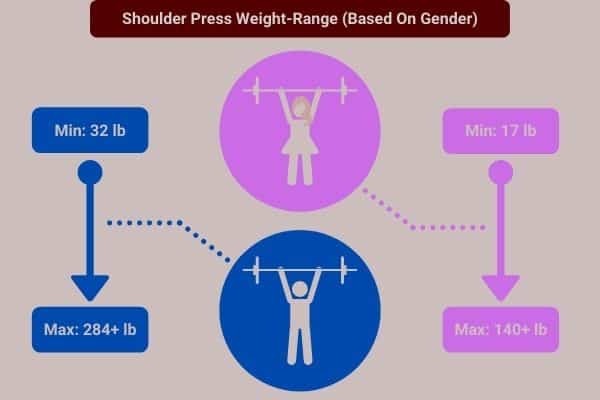
How I produced this statistic:
I referred to the same Strength Level database used for male and female shoulder press standards (fig 1 and fig 2).
This allowed me to determine how much a man or woman is expected to shoulder press at different body weights and training levels.
Here are the shoulder press 1RMs for men at a range of body weights and training levels:
| Bodyweight (lb) | After 1 Month Training (lb) | After 6 Months Training (lb) | After 2 Years Training (lb) | After 5+ Years Training (lb) |
|---|---|---|---|---|
| 110 | 32 | 53 | 80 | 113+ |
| 130 | 44 | 68 | 99 | 136+ |
| 150 | 56 | 83 | 117 | 156+ |
| 170 | 68 | 97 | 134 | 176+ |
| 190 | 79 | 111 | 150 | 194+ |
| 210 | 91 | 124 | 165 | 211+ |
| 230 | 101 | 136 | 179 | 227+ |
| 250 | 112 | 148 | 193 | 242+ |
| 270 | 122 | 160 | 206 | 257+ |
| 290 | 131 | 171 | 218 | 271+ |
| 310 | 141 | 182 | 230 | 284+ |
Men are able to shoulder press in the range of 32 pounds to 284+ pounds. And as expected, the exact weight a man can shoulder press is influenced by his bodyweight and training level.
Now, here are the shoulder press 1RMs for women at a range of body weights and training levels:
| Bodyweight (lb) | After 1 Month Training (lb) | After 6 Months Training (lb) | After 2 Years Training (lb) | After 5+ Years Training (lb) |
|---|---|---|---|---|
| 90 | 17 | 31 | 51 | 76+ |
| 110 | 22 | 38 | 60 | 87+ |
| 130 | 27 | 45 | 68 | 97+ |
| 150 | 32 | 51 | 76 | 106+ |
| 170 | 36 | 57 | 83 | 114+ |
| 190 | 41 | 62 | 89 | 121+ |
| 210 | 45 | 67 | 95 | 128+ |
| 230 | 48 | 71 | 100 | 134+ |
| 250 | 52 | 76 | 105 | 140+ |
Women are able to shoulder press in the range of 17 pounds to 140+ pounds. And just like men, the exact weight a woman can shoulder press will be influenced by her bodyweight and training level.
Check out my other article to find out workout duration to gain muscle.
8. Shoulder Press Strength Progression Based On Gender.
Males are expected to see shoulder press strength progression at a 124% faster rate than females due to a larger hormonal response (especially testosterone and growth hormone). However, this assumes all training and diet variables are kept the same for both groups.
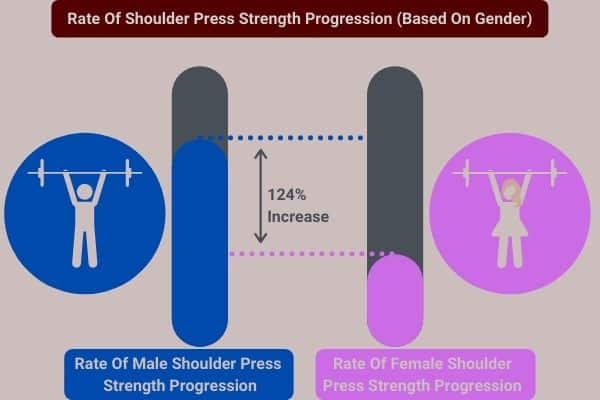
How I produced this statistic:
First, I took the same graphs from fig 1 and fig 2.
Then I drew a line of best fit across all body weights for each training level. This produced fig 3 and fig 4 (see below).
Next, I calculated the gradient of the slope for each line, and used this as an indicator for shoulder press strength progression rate (a steep line indicates faster progression and vice versa).
The calculated gradients have been labeled on each line (see below).
Here are the shoulder press rates of progression for men:
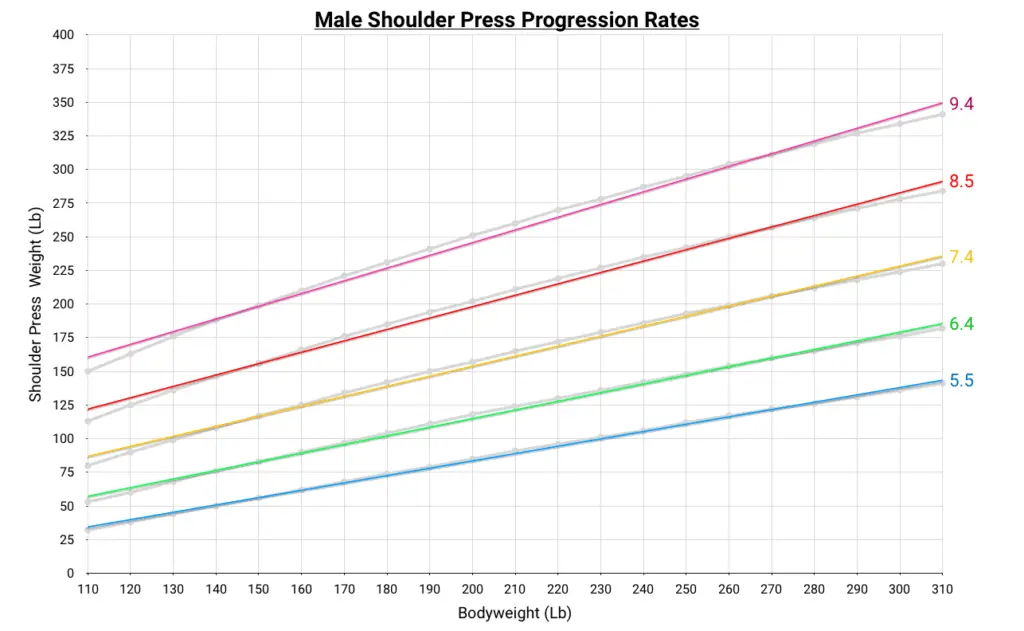
As seen from fig 3 above, the shoulder press rates of progression for men are:
- Beginners- 5.5 slope gradient
- Novices- 6.4 slope gradient
- Intermediates- 7.4 slope gradient
- Advanced- 8.5 slope gradient
- Elites- 9.4 slope gradient
Next, I averaged the gradients for each training level. And this shows that men have an average shoulder press progression rate of 7.4.
Here are the shoulder press rates of progression for women:
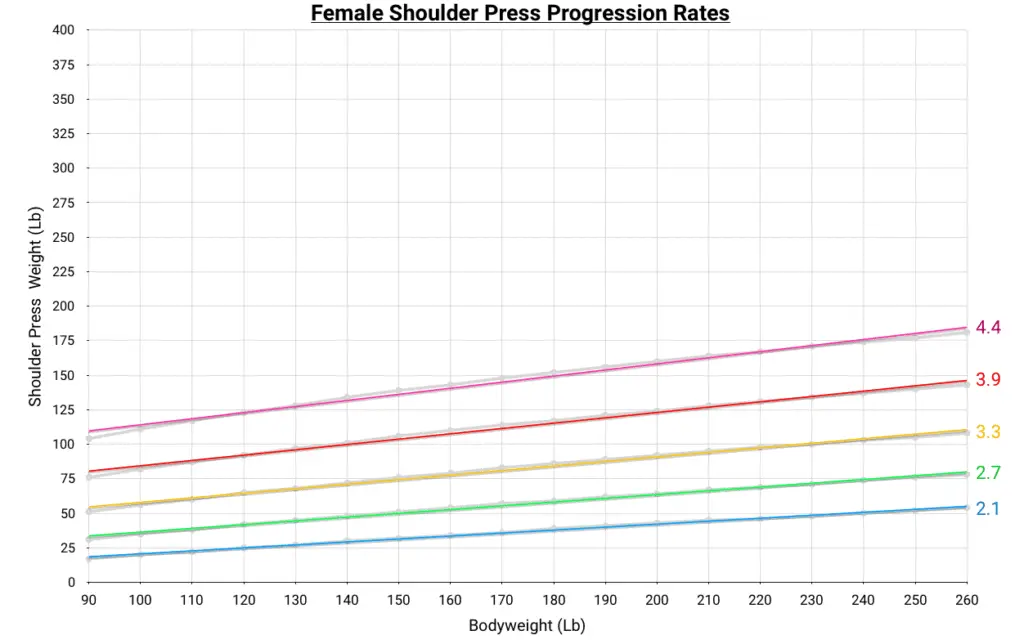
As seen from fig 3 above, the shoulder press rates of progression for women are:
- Beginners- 2.1 slope gradient
- Novices- 2.7 slope gradient
- Intermediates- 3.3 slope gradient
- Advanced- 3.9 slope gradient
- Elites- 4.4 slope gradient
By averaging the gradients for each training level, this shows that women have an average shoulder press progression rate of 3.3.
Taken together, males can expect to see shoulder press strength progression at a 124% faster rate than females.
This difference in strength progression is explained in a 2018 study, which notes that males release much more testosterone and growth hormone in response to training.
9. Shoulder Pressing Is The Best Exercise To Develop Your Shoulders.
The shoulder press activates the deltoids 14.2% more than the bench press. Similarly, the shoulder press also activates the deltoids 12.4% more than the lateral raise. This makes the shoulder press a superior exercise to develop the shoulders, compared to the bench press and lateral raise.
How I produced this statistic:
The deltoids (shoulder muscles) can be trained with lots of different exercises. But this 2020 study sought to find out which is the best for activating the deltoids.
13 men performed the shoulder press, laterall raise, and bench press at 60% of 1RM.
The scientists then used electrodes to study activation of the following muscles:
- Anterior deltoids- front shoulder.
- Lateral deltoids- side shoulder.
- Posterior deltoids- rear shoulder.
Here’s what they found:
| Muscle: | Shoulder Press Muscle Activity (Vs Bench Press) | Shoulder Press Muscle Activity (Vs Lateral Raise) |
|---|---|---|
| Anterior Deltoids | 11.9% higher | 12.1% higher |
| Lateral Deltoids | 22.9% higher | No difference |
| Posterior Deltoids | 7.9% higher | 12.6 lower |
| Average: | 14.2% higher | 12.4% higher |
The shoulder press activates the deltoids between 7.9% to 22.9% more than the bench press (averaging a 14.2% increase).
Similarly, the shoulder press also activates the deltoids between 12.1% to 12.6% more than the lateral raise (averaging a 12.4% increase).
So if you want to get bigger shoulders, make sure you focus on shoulder pressing!
You can also check out my other article to find out how much you should be dumbbell overhead pressing.
Or check out this article to find out how heavy your dumbbell lateral raise should be.
10. Shoulder Pressing With Kettlebells Vs Dumbbells.
The dumbbell shoulder press activates the anterior deltoids by 63.3% of their maximum capacity. In comparison, the kettlebell shoulder press activates the anterior deltoids by 57.9% of their maximum capacity. This shows that dumbbells are more effective at activating the shoulders, compared to kettlebells.
How I produced this statistic:
The shoulders are commonly trained using different types of free weights such as:
- Barbells.
- Dumbbells.
- Kettlebells.
So which training method is the most effective?
This 2018 study made 21 subjects perform the shoulder press using kettlebells and dumbbells.
The scientists also attached electrodes to the participant’s front shoulders. This allowed muscle activity to be measured.
Here’s what they found:
| Shoulder Press Using: | Anterior Deltoid Activation (% Of Maximal Activation) |
|---|---|
| Dumbbell | 63.3% |
| Kettlebell | 57.9% |
The dumbbell shoulder press activates the anterior deltoids by 63.3%. In comparison, the kettlebell shoulder press only activates the anterior deltoids by 57.9%.
Therefore dumbbells lead to a 5.4% higher shoulder activation than kettlebells.
So if you want higher shoulder activation, shoulder press with dumbbells rather than kettlebells!
If you’re looking to buy free weights, then you may be interested in my other article to find out about the average price per lb/lkg of dumbbells and kettlebells.
Recap: Recommended Shoulder Press Setup At Home
I prefer shoulder pressing with dumbbells rather than dumbbells.
Dumbbells are much cheaper and more space-saving than a barbell setup.
Dumbells can also provide most people with more than enough weight to progress onto the advanced stages of shoulder pressing.
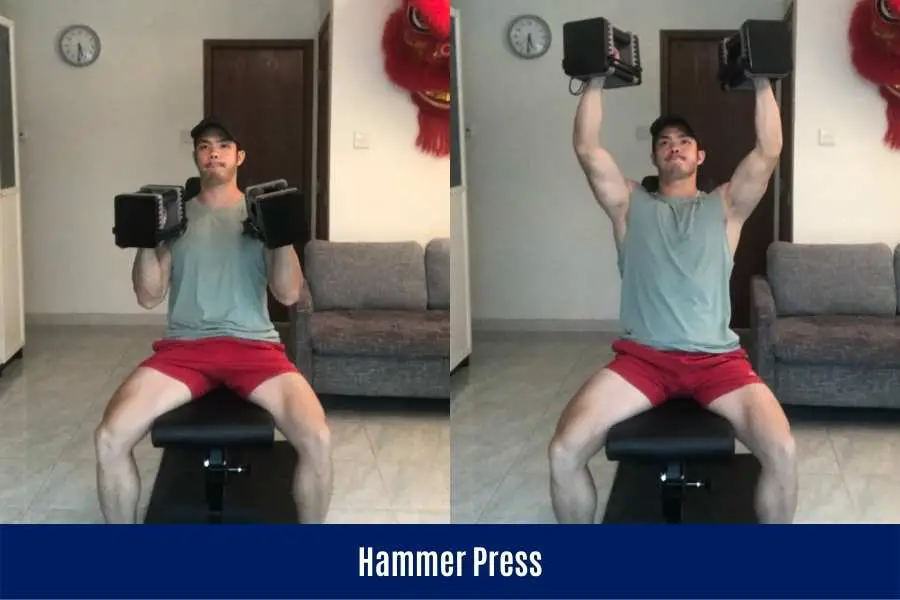
The PowerBlocks are fully adjustable so you can progress from the lighter settings onto the heavier settings as you build pressing strength.
They’re more expensive than most other dumbbells of the same weight, but they’re also the most durable adjustable dumbbell I’ve tested (made with a steel cage design).
They come with a 5-year warranty.
The bench helps to keep your back straight and also serves as a seat. Seated shoulder pressing allows you to lift more weight compared to the standing variation.
Conclusion
That’s 10 of my favorite shoulder press statistics for 2021!
Some of the statistics showcase just how strong the king and queen of the shoulder press are.
Other statistics allow you to benchmark your own shoulder pressing performance.
Furthermore, some of the statistics will help you shoulder press more effectively for shoulder development.
Regardless, I hoped you liked them!
Which was YOUR favorite shoulder press statistics?
Feel free to send me a message if you have any questions! You can find my details on the “contact us” page.
You may also be interested in the downloadable Kalibre Blueprint PDF which details exactly how I gained 40lbs of lean muscle (it’s 100% free!). It details the exact exercises and nutrition (with printable worksheets) I used to go from skinny to ripped!
Thanks for reading guys!
Peace Out,
Kal
(Biochemistry BSc, Biomedical Sciences MSc, Ex-Skinny Guy)


